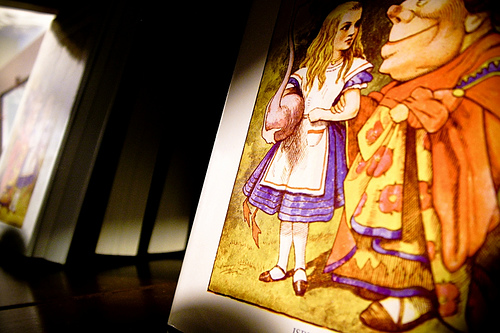Banned Books of Childhood
by Vijay Nair / May 27, 2013 / No comments
Children’s books contain enduring wisdom, but censorious adult minds are too feeble to grasp it.

Lewis Carroll's Alice's Adventures in Wonderland is one of many children's books banned throughout history. Its animals' ability to speak offended the Chinese government in the 1930s. Photo: Kimberly Jones via Flickr.
Last week a friend from India e-mailed me a list of books that have faced censorship at some point in history. I was surprised and also faintly amused when I discovered some of my favorite childhood works on the list. The reasons for their censorship were intriguing and left me wondering how their creators would have responded to the ban if they had been around when the authorities clamped down on the work—especially since, for some, the reasons behind the banning were very strange. For example, Lewis Carroll’s Alice’s Adventures in Wonderland was banned in China in the 1930s because, apparently, the author had the temerity to make animals speak, thereby placing them on equal footing with human beings.
In perusing the list I was also surprised to learn that The Canterbury Tales was considered risqué late into the 20th century, supposedly due to its obscene language and sexual innuendoes. I understand that even now it’s usually available in its abridged version. My first residency was at the University of Kent, Canterbury and I had always imagined Chaucer’s tales to be religious in nature. I felt a bit foolish for not knowing the book’s tumultuous history.
On the other hand, it hurt me considerably to discover that one of my most beloved adventure series from childhood, The Famous Five by Enid Blyton, was banned by the BBC for 30 long years because the hallowed institution felt the writing was not up to the mark. Judging by today’s yardstick, Blyton’s books do feel simplistic and even politically incorrect, but they gave millions of children considerable joy while they were growing up, and I don’t think many of them matured into politically incorrect adults.
I had been vaguely aware of the fact that another one of my childhood favorites, Adventures of Huckleberry Finn, earned critics’ disapproval because of its racial undertones, but I didn’t know it had been frequently challenged and banned in its country of origin. However, upon reflection, I wasn’t surprised by the adverse reactions to the Twain classic. When I discovered that Harper Lee’s To Kill a Mockingbird had met similar resistance I received quite a jolt. In India that classic is taught as an anti-racist work in high school.
The Scarecrow in search of a brain, the Tin Woodman who hunts for a heart, and the Cowardly Lion who believes he could do with a dose of courage are all personal favorites of mine, so it alarmed me a great deal to learn that L. Frank Baum’s legendary tale has been frequently banned in classrooms and libraries. Apparently, one of the many reasons why The Wonderful Wizard of Oz has been derided by authorities is for projecting human skills as being individually developed rather than god-given!
Herge’s comic album, The Blue Lotus, in which Tintin fights a drug gang in Shanghai, has delighted successive generations since its publication in 1936. Both my son and I have rooted for the diminutive hero in our childhood years. But the Chinese government disapproved of the strip for supporting the political party the communists displaced. The ban was lifted only in 1984.
I could never get through Anna Sewell’s Black Beauty. In truth, I find it overtly maudlin, but it dismayed me to discover the book was banned by South Africa’s apartheid regime because the title contained two words the racist authority couldn’t reconcile.
Reading about where and why these beloved childhood treasures were banned has convinced me of one truth: Books for children may contain wisdom that endures for centuries, but censorious adult minds are too feeble to grasp it.
Thankfully none of these works are banned anymore and young minds can explore them for their magic and decide what they can take from a particular work and what they can discard. These books are not dangerous. But those who banned them might have been.




